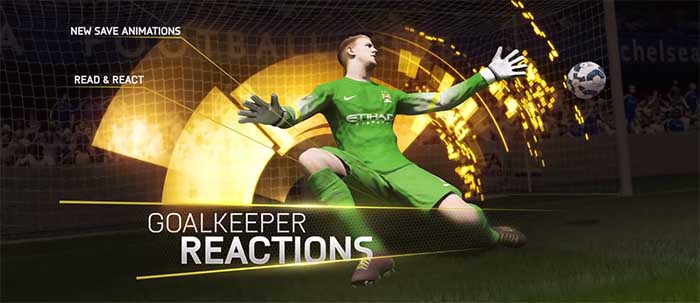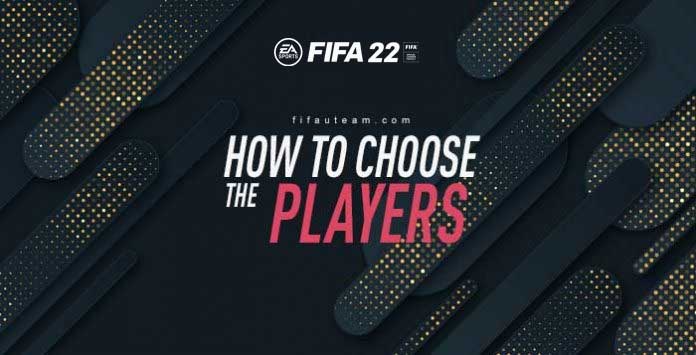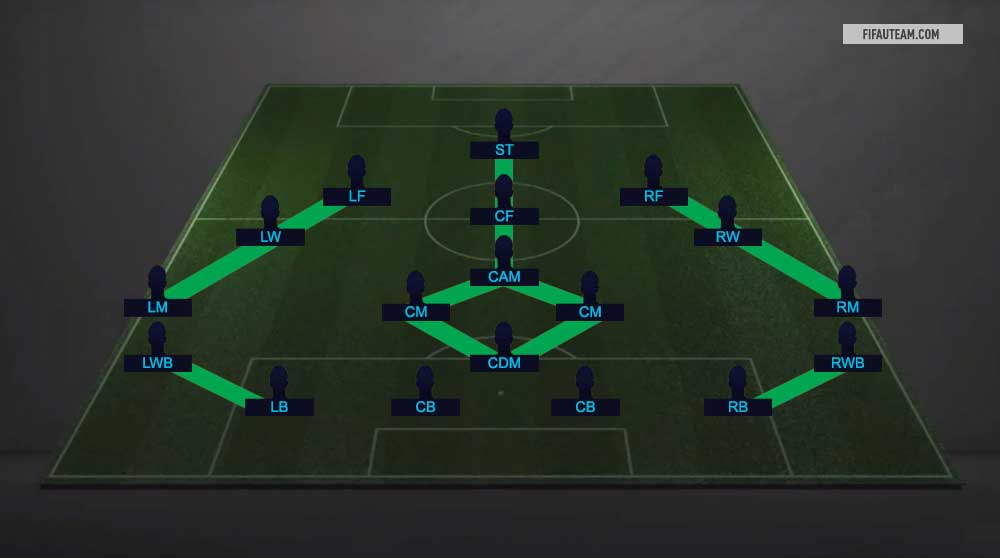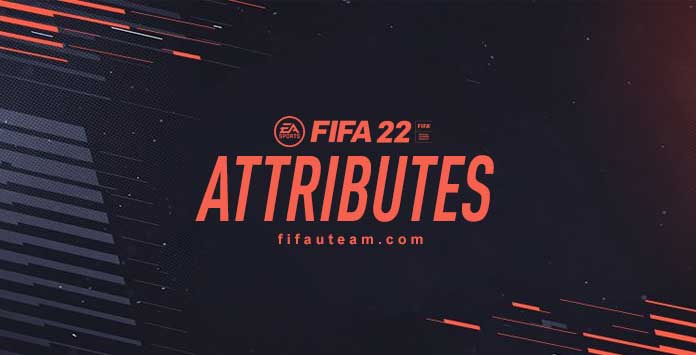You don’t know where to start building your squad? Are you still undecided between two players? Do you need to decide on one more position? It doesn’t matter what your problem is, we’re here to help you. Learn how to choose the best players for your squad on FIFA 22 Ultimate Team.
How to Choose the Best Players on FIFA 22 Ultimate Team
The four criteria
Ultimate Team differs itself from the other game modes by allowing each one of us to build a preferred dream team. One that we’re identified with, that we feel like it’s ours. What makes this such a unique thing is the fact that we all have different tastes.
In order for us to build our team, it doesn’t matter if we know who are the best players or not because this matter is quite subjective. What matters is knowing which players will fit better in our playing style, our formation, budget and squad. This isn’t always an easy task, after all new player’s cards keep coming along through the season, but we’ll give you all the tools needed to build better. Find out who’s your team in FIFA 22 Ultimate Team.
In our opinion, you should pick your players based on the following four criteria:
1 Chemistry
2 Attributes
3 More Characteristics
4 Price
First Criteria: Chemistry
Your starting point
It’s unavoidable. When we want to start a squad from scratch, the first criteria for selecting the players is always chemistry. It forces us to plan how we’re going to spend the coins with antecedence and makes us base it all in one league or nationality. If you have the experience, you might as well choose to build a hybrid squad but you’ll always be subject to the laws of Chemistry.
For people who don’t know, the chemistry affects a player’s performance on the pitch. A player with low chemistry tends, for example, to fail at passing and shooting more easily. In order for you to build good chemistry, besides having your players play in their preferred position, you should put them alongside others that have an element in common: same club, same league and/or nationality. The easiest way to do so is to create teams full of players exclusively from one league or of one nationality. If you want to find the right league for you, please click here.
When you build a squad you’ll obviously be conditioned to the players’ positions. You must choose 18 players and at least one should be a goalkeeper. Then, if you don’t want to have chemistry negatively affected, you’ll have to buy players for the positions you need, according to your formation. They won’t always have to rigorously match since you can use position modifiers, but surely you’ll understand you can’t have all 18 players of the same position.
The question here is how far you can go and disrespect the chemistry. For example, will my performance be that affected if I use a centre-back as a left or a right-back if I see there aren’t good options for those actual positions? Most people will respect chemistry rigorously but it doesn’t necessarily have to be like this. It’s true that we do advise you not to use a player with individual chemistry below 7, but it depends on the alternative. Although there’s no concrete indication, general rule, Messi playing as ST will do better than Griezmann, who is most frequently used for this position on La Liga squads.
If you want to use a player outside of his natural position, you first need to check if he’s got the necessary attributes to play in this new position. This adaptation only makes sense if there’s a notable quality difference between this and the best player you can get for the position, in a way that the change compensates the chemistry loss. Besides, it’s recommended that the positions have some relation to one another so that chemistry is not so roughly affected.
If you try adapting players to new positions, you’ll certainly be surprised with the slight loss of performance the player will suffer, even considering high chemistry reductions. However, it’s important to mention that you should never abuse using these adaptations. If you do it with more than one player in the same team, you’ll start to affect not only the player’s individual chemistry but also the whole squad’s chemistry.
Second Criteria: Attributes
What makes the players play differently from each other
Let’s start by clarify one thing: players are no more than numbers. Although EA works hard to make us believe the players have unique identities, here’s the truth: they’re mere numbers and should be analyzed as such. We do know this isn’t quite easy to accept for people who have experienced unique moments that once connected them emotionally to the players. Deep down it’s good to believe they’re something more than numbers, but doing that is just avoiding the truth, sadly. The player’s physique isn’t what affects his performance, not his traits or specialities (many of them don’t exist on Ultimate Team) either. It’s all on the attributes. They’re the ones responsible to make us feel like each player is different. And they’re the ones you should carefully analyze when planning your squad. Many times one player’s perception changes, according to the game’s difficulty, formation or for any of the dozens of other reasons there are. Still, attributes are the most accurate element that we have in order to compare players.
For pure laziness or lack of knowledge, many people make the terrible mistake of evaluating one player’s quality according to his overall rating. It just shows, how popular and good in specific attributes a player is, so that makes them be compared to others. The rating is NOT an average or reflex of all the attributes. It reveals nothing about the player’s true technical, mental and physical attributes. Sometimes, FIFA 22 players with lower ratings can be better choices.
On FIFA 22 Ultimate Team there are more than 30 attributes that can only be viewed in-game, in the active squad & squad management menu, or else in a database. You’re the only one who knows for sure about the attributes your players need because that’s according to your playing style. If, for example, you like to cross abuse, it’s preferred for you to have wingers with good crossing attributes and strikers with good heading. On the other hand, if you like playing on counter attacks, it’s important for you to have fast attackers and midfielders with good passing. All this is very intuitive, you need to look at your squad line and think about what you want to do with it. If you’re still having a hard time, we’ll help you.
As we said, the player choice should be based on his attributes. Since they’re so many, when we play we get the feeling that it’s not possible to choose them only calling upon the numbers. However, we forget that the numbers are much more accurate than our playing experience, which is corrupted by many factors: our inspiration, the opponent’s quality, changes in our team, several events during the game, etc… We’re not saying you shouldn’t choose players basing yourself on the experience you’ve had with them, but you should form an opinion only after a minimum number of 10 to 15 matches. Besides, most of the time we can’t experiment with all the players we want to come up with the best team, so a good analysis of the players’ attributes first will surely be of great use.
But how is this analysis made? First of all, it’s important to know what each attribute means, what can be done clicking here. Then, it’s also important to realize that the players with the highest attributes are not necessarily the best. Our interest here is to find the right players for our squad, and this is done once we identify the characteristics they should have according to what we can afford, of course. Imagine, for example, that you’re looking for a centre-back to play between two other centre-backs and his main role is to defend. Tackles, Interception, Marking, Jumping, Strength and Heading Acc are the main characteristics he should have. If you wanted to find the ideal player you’d just have to find the one with the highest sum of these attributes. Obviously, it would be good to have the other attributes high, but these are the ones you should focus on for this example. However, things aren’t so simple as this (you already find it complicated?). It’s just that among these attributes, some are more important than others and you should pay attention to this. You should give weights for each one of the attributes so that you can find a weighted average to reflect the perfection of the player you’re looking for. For this example, you could define Tackle worth 35%, Interception 10%, Marking 20%, Jumping 15%, Strength 15% and Heading Acc just 5%.
Even more rigorously, you could create a formula based on your playing style and formation, featuring coefficients that would reflect the importance of the other attributes, work rates, star skills and weak foot. The ideal thing would be to create one weight for each attribute in order to get an absolute final value that wouldn’t depend on anything else. However, besides this being way too painful to do, making all these weights up would be hard for people who don’t perfectly dominate the game. This is why there are other simpler strategies in order to determine how good a player is for our squad, and still that would allow us to come to sufficiently good conclusions.
For people that want to keep things as simple as they possibly can, we recommend them to analyze the basic attributes instead of the IG attributes. This is their role, and this is how most people select their players. The basic attributes are the six face stats shown on the player’s card: pace, shooting, passing, dribbling, defending and physicality. They’re no more than an average between the In-Game attributes. In order to choose a player, you should focus on the basic attributes and casually on one or other IG attribute that you think is crucial for the situation. For example, continuing the case we presented above with the centre back, all IG stats could be substituted by only one, defending, which doesn’t only reflect all these attributes but also weighs each one’s importance for the final stat. So you’d just need to put that analysis along with strength, which isn’t included for defending, but physicality. For that reason, it’s important that we know what each of the six basic attributes corresponds to. Only this way we’ll be able to simplify everything, reducing our analysis to these attributes and then taking a peek at the IG stats we consider important. This knowledge also gives us the possibility to adjust the weights according to our preferences. Now that you’re aware of the importance of the basic attributes, let’s see what they’re made of:
Pace | Sprint Speed (55%), Acceleration (45%)
Shooting | Finishing (45%), Long Shots (20%), Shot Power (20%), Volleys (5%), Att. Positioning (5%), Penalties (5%)
Passing | Short Pass (35%), Crossing (20%), Vision (20%), Long Pass (15%), Curve (5%), FK Accuracy (5%)
Dribbling | Dribbling (50%), Ball COntrol (35%), Agility (10%), Balance (5%)
Defending | Stand Tackle (30%), Defensive Awareness (30%), Interceptions (20%), Heading Acc (10%), Slide Tackle (10%)
Physical | Strength (50%), Stamina (25%), Aggression (20%), Jumping (5%)
If you’re not very experienced, probably you’ll have a hard time identifying which attributes to give more attention to when choosing a player. We don’t know what’s your playing style, but according to your formation and player position, we can suggest the ones that seem like the most important ones. This information can be seen here, along with the work rates we judge ideal for each one of these situations.
In general, these are the attributes we value the most according to the positions:
GK | Reflexes and Diving
CB| Defending, Physicality and Pace for at least one of the centre backs
RB/LB | Defending, Pace and eventually Dribbling for RWB’s and LWB’s
CDM | Defending, Passing and Physicality
CM/CAM | Passing and Dribbling
Wingers | Pace, Dribbling and Passing
CF/ST | Shooting, Physicality and Pace

All this hassle for us to find the ideal players for our squad may look a bit complex since there are so many attributes to take into account. However, it goes downhill when it comes to choosing a goalkeeper. They’ve got only 6 basic attributes. They don’t have IG stats, nor skill moves or work rates. Nothing. Your formation and playing style have no influence on this choice either. They’re simply formed by seven numbers (yes, besides the attributes there’s his height!). This is what makes goalkeepers seem different to each other. You can abdicate yourself from giving attention to feedback saying this is or that goalkeeper concedes easily frequently. This is no good. You’ve seen two or three people complaining about that goalkeeper but, if you look closely, you’ll find more people saying the opposite. The only way you know if a goalkeeper is good or not is through his stats. In our opinion, the descending order for the importance of goalkeeper attributes is: reflexes, diving, handling, positioning, speed and kicking. It’s up to you to weigh them. If you’re defensively passive when the opponent is roaming through the surroundings of your area, you should also give special attention to your goalkeeper’s height, because when they’re shorter the probability for a finesse strike to go in is higher.
Third Criteria: More Characteristics
Height, preferred foot, weak foot, skill moves and work rates
Using a simple spreadsheet program you’ll be able to find the perfect player for your squad. You just need to select the most important attributes and give each one a weight. But then, what if some of the player’s characteristics weren’t measurable? That would be complicated. The truth is that, besides the attributes, you should also watch out for the five characteristics that define them:
Height
Although it isn’t decisive, you should pay attention to the player’s height, especially if he’s a striker, a centre back or a goalkeeper, although it’s also useful for the CDM position. A taller player that has good jumping will win more headers.
Preferred Foot
Carefully verify if you’re using your players correctly for their position on the field, sometimes you should change their side in order to favor their preferred foot.
Weak Foot
This is the type of characteristic that should be decisive when choosing one between two players or more. It’s more important for the player to have good attributes than more weak foot stars, of course, but that’s still interesting for us. If you’re thinking of buying a finisher, don’t forget to check if he’s got a good weak foot. You’ll certainly notice the difference on the pitch between a player with low and high weak foot.
Skill Moves
Players with more skill moves stars will get past the opponents more easily. They can also execute more complex technical movements although this might be more of a show-off than an actual contribution to the team. Most 3 stars skill moves are as effective as (or more than) 5 stars skill moves. Like it is for the Weak Foot, the Skills Moves should determine which player you’re choosing, unless you’re a natural skiller that doesn’t need the means to success.
Work Rates
Unlike the others, this is for us, with absolutely no doubt, a characteristic that you should never look away from when choosing a player. This isn’t where you should start the player selection, do this at the point where you already have a shortlist so this works as an effective eliminatory factor. Avoid low/low work rates, or high/high on players of low stamina. Low offensive work rates on attackers or defensive work rates on defenders are usually bad choices. According to your tactic, playing style and the players you already have you should manage work rates in order for one to compensate the other. For example, two centre backs with low defending work rates is unacceptable, but it’s okay to have just one.
Fourth Criteria: Price
It’s all about money
Well then, shouldn’t this be one of the first criteria? Good question, but we’re already counting that you left Ronaldo and Messi out because you know you don’t have enough coins for them. What we’re going to do now is the opposite. Instead of choosing the cheapest players, we’ll choose the most expensive ones. Are you confused? We’ll explain.
By this part of the article we suppose you already have a pretty good idea of who you want for your squad. In the worst scenario, you’re striving to choose one between two players. Which one should you choose? You probably have a favourite but you just need the final word. Something that will help you decide at a bigger consciousness. Have you searched for someone else’s personal opinion of experience hoping to know if he’s really what you’re looking for? That’s no good. This isn’t the right thing to do. We have nothing against other people’s opinions, but basing your choice on two or three opinions is letting someone else decide for you, really. What you have to do is ask for thousands or millions of people’s opinions. And how do you do that? Well, exactly: it goes by the price. It’s in the title after all, isn’t it?
In a universe so big as the Ultimate Team player’s, there’s no room for mistakes. Bad decisions are easily absorbed by the immensity of good ones. The community isn’t stupid and puts a lot of time into a game that, excuse redundancy, learns to learn. There’s no better way to show how good a player is than setting a price as high as his quality. Nobody likes paying more for a player that they think isn’t worth anything, and only some manage to pay less than his average price. In other words: are you undecided between two players? Go for the one that costs more.
Before you present any arguments to contradict this strategy, let us list a few exceptions to this rule that you’re about to know of:
What about the rest?
So you just choose the most expensive one and it’s all settled? This isn’t what we said. For some reason, this is the fourth criteria. Until you got here you’ve at least taken a look at the players’ attributes and selected those that best fit in your playing style and formation. This is just a tiebreaker factor that will certainly work for most people. The more similar the players are to each other, the higher will be this strategy’s success rate.
But don’t prices change?
Of course, they do. Sometimes players who used to be more expensive become cheaper than their concurrent. If you look closely this happens only once in the game, except for rare situations in which a player will make the difference in real life. In the end, this is proof that the community is alert. What happens is that when the game is released, prices are according to people’s initial expectations. Only after some learning and experimenting time prices will be set for more or less, according to whether the player has been revealed worse or better than expected. For that reason, you should only look at the players’ prices as a choice factor after the first 15 days of the game. On FIFA 22 this was very notorious with the slowest players. Once the community realised pace was OP again the fastest players gained concurrence, hence the price increase.
And doesn’t supply affect the price?
Yes, this is also a factor to be taken into account. Prices are made by the community but are also defined by EA, which can put more or fewer cards of a player in circulation. If they put many cards the price drops. After all, whose fault do you think it is that you don’t have enough coins to buy Messi or Ronaldo? You can’t look at the price of very expensive players or IF versions as a reflection of quality. They are strongly inflated because of the poor supply. No matter how good Ronaldo might be, he’s not worth 500 Benzema’s, right?
What about popularity?
All the calling of attention we did until here has quite an importance because hardly one of these advices will lead you to a mistake. However, you should intensify your attention when comparing two different popular players. The fact that one of them is in form or plays at a highlighted club is enough to make his price rise.
Due to the quick sell value difference between rare and non rare cards, the last ones tend to get devaluated even when it comes to interesting players. It goes the same way as the popularity factor we explained earlier. If you can identify all these things, you’ll be able to choose the best players at lower prices.
Along with this guide we gave you all the tools you need to analyse what are the best choices for your squad. However, the intention wasn’t to depreciate the fun way of finding out if a player is good or not: testing him out. Play, have fun and if you’re having good results with someone, don’t change just because somebody else thinks differently. After all, you don’t change a team that’s winning.


